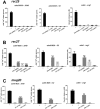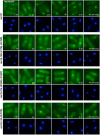Functional organization of protein determinants of meiotic DNA break hotspots
- PMID: 28469148
- PMCID: PMC5431104
- DOI: 10.1038/s41598-017-00742-3
Functional organization of protein determinants of meiotic DNA break hotspots
Abstract
During Schizosaccharomyces pombe meiotic prophase, homologous chromosomes are co-aligned by linear elements (LinEs) analogous to the axial elements of the synaptonemal complex (SC) in other organisms. LinE proteins also promote the formation of meiotic DNA double-strand breaks (DSBs), the precursors of cross-overs. Rec10 is required for essentially all DSBs and recombination, and three others (Rec25, Rec27, and Mug20) are protein determinants of DSB hotspots - they bind DSB hotspots with high specificity and are required for DSB formation there. These four LinE proteins co-localize in the nucleus in an interdependent way, suggesting they form a complex. We used random mutagenesis to uncover recombination-deficient missense mutants with novel properties. Some missense mutations changed essential residues conserved among Schizosaccharomyces species. DSB formation, gene conversion, and crossing-over were coordinately reduced in the mutants tested. Based on our mutant analysis, we revised the rec27 open reading frame: the new start codon is in the previously annotated first intron. Genetic and fluorescence-microscopy assays indicated that the Rec10 N- and C-terminal regions have complex interactions with Rec25. These mutants are a valuable resource to elucidate further how LinE proteins and the related SCs of other species regulate meiotic DSB formation to form crossovers crucial for meiosis.
Conflict of interest statement
The authors declare that they have no competing interests.
Figures





Similar articles
-
Activation of meiotic recombination by nuclear import of the DNA break hotspot-determining complex in fission yeast.J Cell Sci. 2021 Feb 22;134(4):jcs253518. doi: 10.1242/jcs.253518. J Cell Sci. 2021. PMID: 33526714 Free PMC article.
-
Mug20-Rec25-Rec27 binds DNA and enhances meiotic DNA break formation via phase-separated condensates.Nucleic Acids Res. 2025 Feb 27;53(5):gkaf123. doi: 10.1093/nar/gkaf123. Nucleic Acids Res. 2025. PMID: 40037704 Free PMC article.
-
Rec25 and Rec27, novel linear-element components, link cohesin to meiotic DNA breakage and recombination.Curr Biol. 2008 Jun 3;18(11):849-54. doi: 10.1016/j.cub.2008.05.025. Curr Biol. 2008. PMID: 18514516 Free PMC article.
-
The conserved histone variant H2A.Z illuminates meiotic recombination initiation.Curr Genet. 2018 Oct;64(5):1015-1019. doi: 10.1007/s00294-018-0825-9. Epub 2018 Mar 16. Curr Genet. 2018. PMID: 29549582 Review.
-
S. pombe linear elements: the modest cousins of synaptonemal complexes.Chromosoma. 2006 Jun;115(3):260-71. doi: 10.1007/s00412-006-0047-7. Epub 2006 Mar 11. Chromosoma. 2006. PMID: 16532354 Review.
Cited by
-
Pericentromere-Specific Cohesin Complex Prevents Meiotic Pericentric DNA Double-Strand Breaks and Lethal Crossovers.Mol Cell. 2018 Aug 16;71(4):540-553.e4. doi: 10.1016/j.molcel.2018.06.035. Epub 2018 Aug 2. Mol Cell. 2018. PMID: 30078721 Free PMC article.
-
Redirecting meiotic DNA break hotspot determinant proteins alters localized spatial control of DNA break formation and repair.Nucleic Acids Res. 2022 Jan 25;50(2):899-914. doi: 10.1093/nar/gkab1253. Nucleic Acids Res. 2022. PMID: 34967417 Free PMC article.
-
Activation of meiotic recombination by nuclear import of the DNA break hotspot-determining complex in fission yeast.J Cell Sci. 2021 Feb 22;134(4):jcs253518. doi: 10.1242/jcs.253518. J Cell Sci. 2021. PMID: 33526714 Free PMC article.
-
Dynamic configurations of meiotic DNA-break hotspot determinant proteins.J Cell Sci. 2022 Feb 1;135(3):jcs259061. doi: 10.1242/jcs.259061. Epub 2022 Feb 7. J Cell Sci. 2022. PMID: 35028663 Free PMC article.
-
Linear elements are stable structures along the chromosome axis in fission yeast meiosis.Chromosoma. 2021 Sep;130(2-3):149-162. doi: 10.1007/s00412-021-00757-w. Epub 2021 Apr 7. Chromosoma. 2021. PMID: 33825974 Free PMC article.
References
Publication types
MeSH terms
Substances
Grants and funding
LinkOut - more resources
Full Text Sources
Other Literature Sources
Molecular Biology Databases

